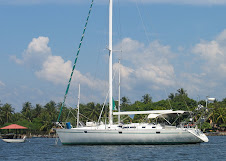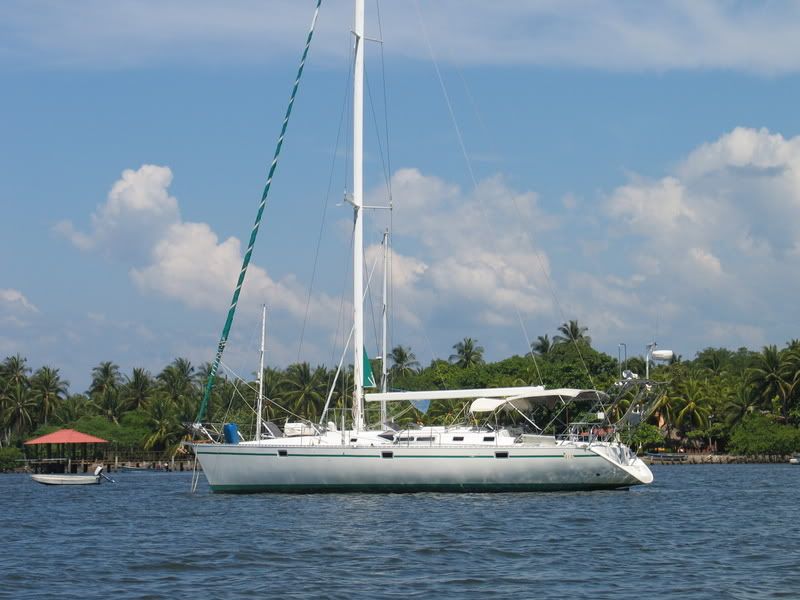
November 9, 2007
shopping

Shopping in El Salvador is an all day experience. First you have to take the "chicken bus" to town. These buses are usually adorned with either religious or Hollywood icons and almost always have stereos cranked up to the maximum level, often to distortion. If you are really unlucky, you may catch a bus with a boom box as well as the usual large box speakers hung from rusty wires.
I am told that there is one phrase that English people don't have to learn - that is: "can you turn up the volume?"
Here we hope to share some of of shopping images:
This is our trip to La Herradura. We get there by dingy up the estuary it is a rough and tumble town most tourists never visit. I was told that there are a whole bunch of El Salvadorian gangsters who were kicked out of the US for being bad dudes living there. It's a little intimidating walking around this village, as we recieve a lot of stares and comments. Most are willing to help and want to sell something. Long gone are my Superstore one stop shops. We actually have to hunt for stuff around here. Today we are off for produce. Banana's avacados, tomatoes, cukes, cabbage, onions, garlic, potatoes, papaya, peppers limes and smelly cheese is usually what you can find in the Saturday central market. The local stores have little to sell beyond beer, candy and cell phone minute cards.
November 6, 2007
Kids just wanna have fun

Kids can certainly be resourceful when they want to be. Chantal had scrounged up a surf board from a cruiser here and we rigged up a wake board off of our dingy.
By using a bridal tied to a life jacket for floating line and a chunk of rubber hose for a handle, we constructed a wake board set up. The girls call this land locking. The locals got quite a chuckle watching the girls surf around the estuary. Apparently they started something. Yesterday we saw someone else try the same set up. It is a bit of a chore starting up but one the pressure is off the board its easy. Josee was the first to get up and surf around. These girls had this set up the first week we were here.
Chantal is a good boat operator and is enjoying her time here..its fun to have her here.
Genevieve enjoys meeting all the other cruisers and hearing about the cruising areas around here.
When the swell is good the kids are at the beach...when the tide is high slack they are "landlocking" and then there is school.....
The Rainy Season

I am told there are 2 seasons in El Salvador; the Dry and the Wet. Upon our arrival, we really began to understand wet. We spent the first couple of days in a hotel at the Marina hoping to make the transition from land to boat a little easier. On our first day our toilet flooded the entire room, soaking all our luggage while we were enjoying our selves at the beach. We had not unpacked yet, did I mention we had 500 pounds of luggage? It contained mostly marine electronics so we were pretty freaked out about possible damage. Lucky we fared well, the only damage was a microphone and school text book that some how disappeared in the clean up process.
At first the rain came in fits and starts, mainly in the evening accompanied by thunder and lots of lightning. Then it really got wet just as if someone turned on a shower. This down pour lasted lasted for 6 days...my job was now is mold control.
Here I am wiping off the mildew...vinegar and bleach are my weapons of choice
I purchased an airconditioner in San Salvador - Which changed our lives. Josee and I had been suffering from strange looking rashes due to the moisture. All of our clothing and bedding was damp dispite repeated efforts of drying. The air conditioner sucked out most of the moisture and we dried up the rest using drying crystals and fans. By clearing out all wet material off the boat and ventalation we are dryer. The trick is not to let any wet stuff stay in the boat.
September 16, 2007
El Salvador History Brief
History
The Pipil Indians, descendants of the Aztecs, likely migrated to the region in the 11th century. In 1525, Pedro de Alvarado, a lieutenant of Cortés's, conquered El Salvador.
El Salvador, with the other countries of Central America, declared its independence from Spain on Sept. 15, 1821, and was part of a federation of Central American states until that union dissolved in 1838. For decades after its independence, El Salvador experienced numerous revolutions and wars against other Central American republics. From 1931 to 1979 El Salvador was ruled by a series of military dictatorships.
In 1969, El Salvador invaded Honduras after Honduran landowners deported several thousand Salvadorans. The four-day war became known as the “football war” because it broke out during a soccer game between the two countries.
In the 1970s discontent with societal inequalities, a poor economy, and the repressive measures of dictatorship led to civil war between the government, ruled since 1961 by the right-wing National Conciliation Party (PCN), and leftist antigovernment guerrilla units, whose leading group was the Farabundo Martí National Liberation Front (FMLN). The U.S. intervened on the side of the military dictatorship, despite its scores of human rights violations. Between 1979 and 1981, about 30,000 people were killed by right-wing death squads backed by the military. José Napoleón Duarte—a moderate civilian who was president from 1984 to 1989—offered an alternative to the political extremes of right and left, but Duarte was unable to end the war. In 1989, Alfredo Cristiani of the right-wing Nationalist Republican Alliance (ARENA) was elected. On Jan. 16, 1992, the government signed a peace treaty with the guerrilla forces, formally ending the 12-year civil war that had killed 75,000.
In 1998, Hurricane Mitch devastated the country, leaving 200 dead and over 30,000 homeless. In Jan. and Feb. 2001, major earthquakes struck El Salvador, damaging about 20% of the nation's housing. An even worse disaster beset the country in the summer when a severe drought destroyed 80% of the country's crops, causing famine in the countryside.
In 2004, Antonio Saca of ARENA was elected president. The nation implemented a free-trade agreement (CAFTA) with the U.S. in March 2006, the first Central American country to do so.
The Pipil Indians, descendants of the Aztecs, likely migrated to the region in the 11th century. In 1525, Pedro de Alvarado, a lieutenant of Cortés's, conquered El Salvador.
El Salvador, with the other countries of Central America, declared its independence from Spain on Sept. 15, 1821, and was part of a federation of Central American states until that union dissolved in 1838. For decades after its independence, El Salvador experienced numerous revolutions and wars against other Central American republics. From 1931 to 1979 El Salvador was ruled by a series of military dictatorships.
In 1969, El Salvador invaded Honduras after Honduran landowners deported several thousand Salvadorans. The four-day war became known as the “football war” because it broke out during a soccer game between the two countries.
In the 1970s discontent with societal inequalities, a poor economy, and the repressive measures of dictatorship led to civil war between the government, ruled since 1961 by the right-wing National Conciliation Party (PCN), and leftist antigovernment guerrilla units, whose leading group was the Farabundo Martí National Liberation Front (FMLN). The U.S. intervened on the side of the military dictatorship, despite its scores of human rights violations. Between 1979 and 1981, about 30,000 people were killed by right-wing death squads backed by the military. José Napoleón Duarte—a moderate civilian who was president from 1984 to 1989—offered an alternative to the political extremes of right and left, but Duarte was unable to end the war. In 1989, Alfredo Cristiani of the right-wing Nationalist Republican Alliance (ARENA) was elected. On Jan. 16, 1992, the government signed a peace treaty with the guerrilla forces, formally ending the 12-year civil war that had killed 75,000.
In 1998, Hurricane Mitch devastated the country, leaving 200 dead and over 30,000 homeless. In Jan. and Feb. 2001, major earthquakes struck El Salvador, damaging about 20% of the nation's housing. An even worse disaster beset the country in the summer when a severe drought destroyed 80% of the country's crops, causing famine in the countryside.
In 2004, Antonio Saca of ARENA was elected president. The nation implemented a free-trade agreement (CAFTA) with the U.S. in March 2006, the first Central American country to do so.
The Containers

One of the most difficult things about buying a boat away from your home port is getting all the stuff you need or think you need to the boat.
Add on the difficulty of getting it through several customs and border hassles this makes for a lot of head scratching.
We tossed around the idea of getting our stuff down via motor home. The idea: we would disguise everying as RV equipment. We nuked this idea after hearing about many horror stories of border crossings involving several bond issues, not to mention getting a truck and trailer suitable for the trip...
I stopped mid stream and as we were purusing RV trailers.. Heck are we sailing or R'Ving!
Thanks to a lot of networking on Michel's part we were able to hook up with an El Salvador business man interested in starting a marina. He really was an asset in getting our ball rolling as far as shipping goes.
So we will give it a shot and wait for the 3 containers to arrive. $$$$$
We are shipping a huge generator, fridges, anchors, chain and lots of other boat paraphernalia...I keep asking about the water line...Michel assures me we have lots of room.
He certainly has a lot of projects in these crates. Being a cabinet worker he just could not resist building something for the boat. He has included a new drawer system, dining table and navigation station cabinet. ( and all the woodworking tools) oh, yeah, apparently I am starting a canvas business too. We could not get our Bimini built in Canada so I have do this myself. Along with all the crates is sunbrella and a whole wack of industrial sewing equipment. Every time I turn abound another thousand bucks falls out of my pocket.
Just to get the girls through the school year cost 1700.00 bucks and 5 boxes of School supplies! This should be interesting at the customs end in El Salvador.
Subscribe to:
Posts (Atom)


